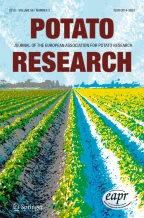Summary
A field experiment with potato (Solanum tuberosum L., cv. Vebeca) was conducted on a sandy soil near Wageningen (52° North) in 1992. The treatments included a zero-nitrogen control and combinations of three amounts of nitrogen, viz. 110, 180 and 250 kg N ha−1, and splitting of the N dose in one (early May), two (early May and June) or three (early May, June, July) applications. The chlorophyll content of the uppermost fully grown leaves was assessed with a SPAD-502 chlorophyll meter (Minolta, Osaka, Japan) throughout the season. The pattern of change with time in SPAd-values differed between treatments. SPAD-502 readings correlated well with laboratory measurements of the chlorophyll content and with the nitrogen concentration in leaves (r 2>0.95). Data on the nitrate concentration in petiole sap (included as a reference) showed that this variable responded much more to split nitrogen applications than the SPAD-value. Future research will need to consider other factors which may affect the chlorophyll content of the foliage.
Similar content being viewed by others
References
Biemond, H. & J. Vos, 1992. Effects of nitrogen on the development and growth of the potato plant. 2. The partitioning of dry matter, nitrogen and nitrate.Annals of Botany 70: 37–45.
Bruinsma, J., 1963. The quatitative analysis of chlorophylls a and b in plant extracts.Photochemistry and Photobiology 2: 241–249.
Dwyer, L. M., M. Tollenaar & L. Houwing, 1991. A nondestructive method to monitor leaf greenness in corn.Canadian Journal of Plant Science 71: 505–509.
Inada, K., 1963. Studies on a method for determining the deepness of green color and chlorophyll content of intact crop leaves and its practical applications. I. Principles of estimating the deepness of green color and chlorophyll content of whole leaves.Proceedings of the Crop Science Society (Japan) 32: 157–162.
Matsuzaki, A., K. Karia, H. Machida & K. Tsunoda, 1980. Studies on the growth control and the nutritional diagnosis in rice plants. I. The nutritional diagnosis based on leaf color and the estimation of the number of spikelets per unit area.Japanese Journal of Crop Science 49: 439–444.
Nitsch, A. & E. Varis, 1991. Nitrate estimates using the Nitracheck Test for precise N-fertilization during plant growth and, after harvest, for quality testing of potato tubers.Potato Research 34: 95–105.
Piekielek, W. P. & R. H. Fox, 1992. Use of a chlorophyll meter to predict sidedress nitrogen requirements for maize.Agronomy Journal 84: 59–65.
Takebe, M., T. Yoneyama, K. Inada & T. Murakami, 1990. Spectral reflectance ratio of rice canopy for estimating crop nitrogen status.Plant and Soil 122: 295–297.
Turner, F. T. & M. F. Jund, 1991. Chlorophyll meter to predict nitrogen topdress requirement for semidwarf rice.Agronomy Journal 83: 926–928.
Van Loon, C. D., J. H. G. Slangen & J. H. Houwing, 1987. Nitrate content of leaf petioles as a guide to optimization of N-fertilization of ware potatoes.EAPR Abstracts of Conference Papers and Posters. 10th Triennial Conference of the European Association for Potato Research, Aalborg, Denmark. pp. 146–147.
Vos, J. & P. C. Struik, 1992. Crop responses to nitrogen. In: J. L. Meulenbroek (Ed.), Agriculture and environment in Eastern Europe and The Netherlands. Wageningen Agricultural University, Wageningen. pp. 195–205.
Wood, C. W., P. W. Tracey, D. W. Reeves & K. L. Edmisten, 1992. Determination of cotton nitrogen status with a hand-held chlorophyll meter.Journal of Plant Nutrition 15(9: 1435–1448.
